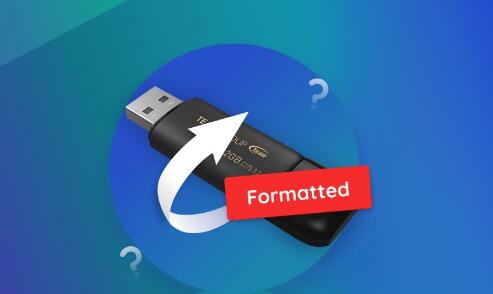They are compact, efficient, and easy to use, making them a preferred option for students, professionals, and casual users alike. However, despite their utility, USB drives are not immune to data loss—one of the most common causes being accidental formatting. When a USB drive is formatted, the files on it may seem irretrievably lost. Fortunately, with the right tools and prompt action, recovering files from a formatted USB drive is often not only possible but also highly successful.
USB Drive Formatting
When you format a USB flash drive, the system erases the directory structure that keeps track of where files are stored. Although the data itself remains on the drive until it is overwritten, the references pointing to the data are deleted. There are generally two types of formatting:

1. Quick Format
Quick format only erases the file system table, making the data invisible but still recoverable.
2. Full Format
Full format scans the disk for bad sectors and may overwrite data, making recovery more difficult.
Understanding which type of format was performed is essential because it affects the likelihood of successful data recovery.
Common Reasons for Formatting a USB Drive
Accidental formatting during routine maintenance or due to user error.
File system corruption that prompts the user to format the drive.
Compatibility issues when using the USB on different operating systems.
Malware infection that damages the file system and requires reformatting.
Error messages prompting formatting to restore usability.
Immediate Steps After Formatting
The actions you take immediately after formatting significantly impact the chances of a successful recovery:
Stop using the USB drive immediately.
Do not save new data to the drive to avoid overwriting.
Safely remove the USB drive from your device.
Connect it to a trusted computer for recovery.
How Data Recovery Works on a Formatted USB
When a USB drive is formatted, the data isn’t actually erased—it is simply marked as free space. Specialized data recovery software scans the drive for these “deleted” files and attempts to reconstruct the directory structure. Depending on the formatting type and how much the drive has been used afterward, the success rate can be very high.
Recover Files from a Formatted USB Drive
Panda Assistant
Panda Assistant offers an easy-to-use interface and advanced scanning technology to recover files from formatted USB drives.
Key Features:
Supports a wide array of file types and file systems.
Offers deep and quick scan options.
Previews recoverable files.
Compatible with Windows and macOS.
Download and install Panda Assistant from its official site.
Insert the formatted USB drive into your computer.
Launch the software and select the USB drive.
Choose a scan mode: Quick scan for recently deleted files, or Deep scan for more thorough recovery.
Review the list of found files and preview them to ensure they’re intact.
Select files for recovery and save them to a different drive.
Types of Files You Can Recover
Documents: DOCX, PDF, XLS, PPT, TXT
Images: JPG, PNG, RAW, GIF
Videos: MP4. MOV, AVI, WMV
Audio: MP3. WAV, AAC
Archives: ZIP, RAR, TAR
Limitations of Software-Based Recovery
While recovery software is highly effective, it has limitations:
Data overwritten by new files cannot be recovered.
Full format or corrupted sectors may prevent full recovery.
Physically damaged USB drives may be unreadable.
When to Use Professional Recovery Services
If your drive is physically damaged or software tools fail, professional recovery labs may be your last hope. These services offer:
Clean room environments for handling hardware.
Specialized tools for severe corruption.
Higher success rates for complex recoveries.
Preventive Measures
Always back up important data to multiple storage devices.
Label your drives clearly to avoid accidental formatting.
Avoid using USBs across multiple systems if possible.
Invest in quality USB drives from reputable brands.
Install antivirus software to prevent malware-induced formatting.
Real-World Case Study: Office Presentation Gone
Imagine a student finishing a semester project stored on a USB drive. The night before the final presentation, they mistakenly format the USB while trying to clean it. Panic ensues. Fortunately, they download Panda Assistant, run a deep scan, and recover the PowerPoint, along with several draft versions. The next day, the presentation goes off without a hitch all thanks to prompt action and reliable recovery software.
About us and this blog
Panda Assistant is built on the latest data recovery algorithms, ensuring that no file is too damaged, too lost, or too corrupted to be recovered.
Request a free quote
We believe that data recovery shouldn’t be a daunting task. That’s why we’ve designed Panda Assistant to be as easy to use as it is powerful. With a few clicks, you can initiate a scan, preview recoverable files, and restore your data all within a matter of minutes.

 Try lt Free
Try lt Free Recovery success rate of up to
Recovery success rate of up to









